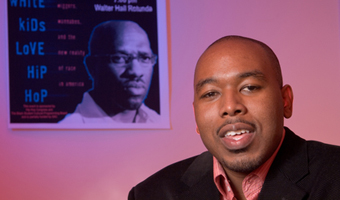Dr. Akil Houston, Assistant Professor of African American Studies, was quoted in an article by Claire Landsbaum on “Get over here, man: Decoding the bro-hug.”
About 25 seconds into Tupac Shakur’s music video for the 1993 hit “I Get Around,” it happens. Shakur walks through a pair of French doors onto a porch, turns to his left where one of his friends is standing, and pulls him into a four-step embrace: hand clasp, shoulder bump, back pat, release. It’s a casual, cool greeting, and both men smile as they carry it through to completion. With one simple gesture, Shakur seems to say to his friend: “You belong here.”
His greeting has many names: bro-shake, bro-hug, hip-hop hug, pound, dap. Whatever name it goes by, in the last 30 years the gesture has become ubiquitous—it’s almost impossible to walk across a college campus or into a bar without seeing it performed. I’ve even tried it, but my bro hug had none of the natural grace of Tupac’s, and my guy friends responded with blank stares. It’s clearly a man’s greeting, and its popularity in this moment in time is no coincidence….
But enlightened as we may be, it’s still important for men to defend, as Dr. Akil Houston of Ohio University calls it, their “fragile notion of masculinity.” Thus the bro-hug: A socially acceptable display that combines affection with aggression. Men can hug each other in public, but they maintain an arm barrier between their torsos and pat each other just once or twice on the back.
According to Houston, who studies hip-hop, the bro-hug was originally an African-American cultural practice. Its initial spike in popularity probably occurred in the 1980s, when channels like MTV, BET, and Video Music Box launched, serving up hip-hop culture to millions of new viewers. Once visible in the mainstream, the formerly niche bro-hug began to be imitated en masse.
This, says Houston, is how the bro-hug spread, but it’s not where it began. The gesture itself is much older, and tied to the history of black oppression. “Generally, if you look at how people have resisted oppression, one of the key ways is through the body,” he says. “Expressions that go against proper decorum are a way for people to exert themselves and express their humanity.” The antithesis of the bro-hug would have been the gentleman’s handshake.
Read the rest of the story at “Get over here, man: Decoding the bro-hug.”

















Comments